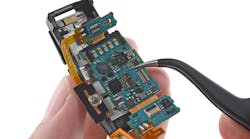Power Management IC Boosts Battery Life Up to 20% in Wearables
Maxim Integrated rolled out a compact chip that promises to replace up to 40% of power management components used in wireless earbuds and other wearables, saving valuable space in these tightly packed devices. It said the power management IC (PMIC) offers an up to 50% smaller footprint than the parts it replaces and bolsters battery life by up to 20%, giving customers the freedom to add more features to their devices.
Maxim Integrated said its MAX77654 is suited for devices with severe space constraints, ranging from wireless earphones and smart watches that can be paired to smartphones, where long battery life is mandatory. Electronics manufacturers are looking to shrink the form factor of wearables while boosting battery life or shrinking the battery size. These firms are also under pressure to reduce heat and protect against electrical noise.
This chip has "the smallest form factor solution with the highest system efficiency," said Karthi Gopalan, who leads the development of mobile power management ICs at Maxim.
The chip is based on a compact buck-boost regulator that supports three independently programmable power rails. The voltage rails are used to share power from the battery to other parts of the system, like the power lines protruding from a tiny electrical substation. The wide output voltage range of 0.8V to 5.5V is ideal for Internet of Things devices where the battery voltage starts out higher than the required output but falls as battery drains.
It also features integrated battery charging with charge currents that can be programmed from 7.5 mA to 300 mA and termination currents that range from 0.375 mA to 45 mA. The chip, ideal for the small batteries used in the Internet of Things, also monitors the battery's temperature and regulates current to stop it from overcharging or undercharging. These types of faults could lead to excessive heat or inflict permanent damage on the battery.
Maxim Integrated said the chip incorporates up to 40% of the components used in the power management system. That slashes the cost—the bill of materials (BOM)—by nearly 25%, the company said. The chip replaces three buck-boost converters, each with its own discrete inductor, with a single converter paired with a single inductor, which is used in stepping down or stepping up the output voltage from the lithium-ion battery.
Cramming all the power management components on the same chip boosts the battery life of the overall system, according to Maxim Integrated. The standby current is slashed, with around 0.5 uA of shutdown current and another 6 uA of supply current, prolonging the remaining charge of the battery. The chip also reduces voltage ripples in the power supply due to electrical noise, with the voltages varying only 20 mV from peak to peak.
The chip features low dropout regulators (LDOs), which are used when there are slight differences in the battery voltage and the output voltage in the power supply. These can also serve as load switches to disable the delivery of power to inactive parts of the device, easing the load on the battery. The general purpose IOs (GPIOs) and a bidirectional I2C interface can be used to control and check the status of the power management IC.
Kevin Anderson, semiconductor analyst at market researcher Omdia, said "size and power constraints are defining next generation IoT consumer system designs, and engineers are finding it harder to cram all the high-performance demands and capabilities into these tiny form factors." He added that Maxim Integrated's power management IC "offers designers flexibility to add new capabilities while also reducing the size and improving battery life."
The power management IC is attached to a tiny 6.5 mm by 6.5 mm by 0.4 mm package. Maxim Integrated has started selling the MAX77654 for $2 each in thousand unit orders.

